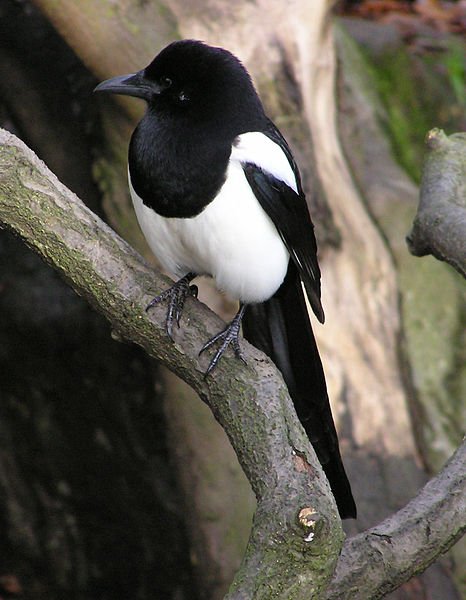What the Hoax?! [ENG/ITA]
Now let's take a specific case. The only living being who uses his brain much better than us: the dolphin. This incredible animal is believed to use up to 20% of its brain capacity.
How many times has this statement been repeated? How many times have we hoped that our brain was not "all here"? That in reality there was an unknown area of the brain, unexplored, that can make us able to perform incredible deeds? Well, unfortunately this statement is false, and has no scientific basis: some aspects of the brain remain unknown, but all the portions of the brain and the corresponding functions are known.

Immagine CC0 Creative Commons - Source
Very often the popular beliefs give for sure, by truth, what a more careful analysis turns out to be false. Science itself does not always foresee a linear path, stumbling into the truth of today that tomorrow will be errors. Churchill said that "a lie has time to do half a turn of the world before the truth can get his pants".
In today's world, where hoaxes travel fast and sometimes take the place of truth, it is important to always check the news, so that lies can be unveiled and stopped on time; because if some are simply absurd and funny, many others can be dangerous.
We then take this opportunity to point out the heading Debunk-Tuesday by @egotheist, who every Tuesday tries to debunk some of the fanciful theories that afflict the world today.
Urban legends in biology
The world of biology is certainly not unknown to the great circus of beliefs and urban legends; on the contrary, with the increasing diffusion of the internet, the number of all-rounders constantly increases, convinced that they can master entire subjects after reading a Wikipedia page. Here are some of the most common legends about the animal and vegetable world.

Immagine CC0 Creative Commons - Source
Many (especially your children) will be pleased to find that spinach is by no means the most suitable food to take large amounts of iron and develop their muscles. A comma placed badly in one of the first food tables did indeed increase the milligrams of iron contained in 100 grams of spinach from 3 to 30. In fact, to reach the correct dose of daily iron a feast of spinach is not enough! Do not overlook the fact that spinach contains a high quantity of oxalates, inhibitors of iron intake. We do not know with
certainty the author of this error, which dates back to the second half of 1800, and it is crazy to think that this life has consequences today.
In the common imagery the romantic image of the wolf who is howling at the moon, perhaps full, is very deeply rooted. In reality, the singing of the wolf has an important social function of cohesion within the herd and serves to mark its territory to potential rivals. The wolf therefore does not only howl at night, and certainly does not do it at the full moon!
Another nice belief, abused in many cartoons, concerns the elephants, which the legend wants to be terrified by animals much smaller than themselves, the mice. Probably the worst thing that could happen to an elephant in the presence of a mouse is that it sneaks into its proboscis, but if you were a mouse ... Would you really have interest in getting into the wet nose of a big pachyderm? In fact, elephants are not absolutely afraid of rodents. To dispel this myth, Bernhard Grzmek, the director of the zoo in Frankfurt put rats in front of his elephants: no panic attacks on the part of the elephants, but only a few mice crushed. It is thought that this belief originated during the counteroffensive of the Romans against the Carthaginian general Hannibal who, with elephants in tow, crossed the Alps in 218 BC.; The Romans defended themselves by setting fire to pigs covered with grease and pitch, arousing them against the elephants of Hannibal. These gave themselves to escape and the story marked a historic victory of the children on the big, which was transmitted in years of history up to us with the imaginary belief.

Immagine CC0 Creative Commons - Source
Continuing in the wake of the great animals, another widespread belief concerns the bears, who spend the winter in hibernation in the collective imagination. In fact, during the cold season, the bears withdraw into their burrows and sleep almost all the time, without eating and drinking; their body temperature and physiology, however, do not undergo any noticeable variation. Hibernation is a completely different process: it is an energy-saving sleep that involves a controlled reduction of body temperature (the production of which costs energy) to resist for a long time without having to feed. Bears therefore actually only sleep during the winter.
The panda do not really have 6 fingers. The thumb of the panda is actually a very swollen sesamoid bone with articulation and movement thanks to the muscles. This trick, developed in the course of evolution and selected by natural selection, allows the panda to focus on objects.
Another falsehood concerning the mammals is the belief that they do not make the eggs: this is true, but not for everyone. The order of the Monotremes, of the class of the mammals, foresees species characterized by the ability to lay their eggs; among these are the platypus and the echidna.

Immagine Public Domain - Source
The magpie is a bird very rooted in popular culture, and for this reason its behaviors are very often anthropized. It is a common opinion that these birds are used to stealing precious objects. In reality there are no documents, photos or testimonies of birds in the act of accumulating objects that are not edible. The magpies, during periods of great abundance, tend to accumulate provisions, including many objects from the human environment ... But certainly not precious or shiny objects! Episodes of theft of bird and animal feed, meat, excrement, cheese, tubers and vegetables are documented. The magpies are however attracted by bright colors and plays of light, and probably the legend originates from these circumstances.
There are, however, an infinity of other little legends about the animal world, starting from shrimp that do not move only walking backwards, up to the infamous piranha, which in natural conditions are much less aggressive and ravenous than they are painted.
Then there are a series of beliefs that are inspired by events and facts that are absolutely real but that, as for the magpie thief, man has been humanized to such an extent as to reach totally wrong conclusions.
An example is the legendary cry of compassion of one of the most ferocious predators on Earth: the crocodile tears. Legends related to crocodile tears date back to the thirteenth century. Bartolomeo Angelico (a French monk) described in fact a particular behavior of these predators while they were busy to devour their prey: he noticed that these ferocious animals cried the death of their victims with bitter tears. Of course, after biting a zebra, the crocodile feels the same remorse that you would try to grill at the 15th of August after having drunk plenty of beer.
The truth is that the act of chewing stimulates a gland located in the upper lip that has the function of lubricating the eye, and this temporarily increases the tearing.

Immagine CC BY 2.0 - Source
Conclusions
If in some ways the processes that led to the birth of these legends are, all in all, understandable, it is crazy to think that many of these still survive today, and are often defended as absolute truths. Some of these beliefs, as in the case of crocodile tears, provide a distorted view of reality, and are able to find a correct scientific position only when the filter of our human emotions is eliminated. The crocodile does not cry because it feels compassion, but for a series of physiological processes. It is therefore possible to observe how most beliefs and legends derive from the observation of nature imbued with human emotions and convictions.
Thomas Henry Huxley argued that "irrationally defended truths can be more damaging than errors with rational foundation". In fact, from a small belief, truth can derive without any scientific basis. A fairly common example is that of tetanus. Even today, most people believe that it is possible to contract the disease by injuring themselves with rusty objects. Actually the etiologic agent of tetanus is a bacterium, the Clostridium tetani, which is found in the earth in the form of spore. It was a very common disease among peasants, who often cut themselves with the objects of the trade, which were often rusty. The disease, however, was contracted at a later time, when the earth went to settle in the wound. There is therefore no connection with rust. Similar to the case of tetanus, in the past there are beliefs that malaria was literally caused by bad air. From this belief originate various legends such as the curse of Tutankhamun, according to which entering the tomb would lead to death. Only later it was discovered how the causes of the deaths of archaeologists were ascribed to various factors, including malaria.
As said at the beginning of this post, then, it is essential to dispel these legends because, if many can be fun, others (such as that of tetanus) can lead to mistaken beliefs and even serious problems.

Un mo(n)do di dire
Ora prendiamo un caso specifico. L'unico essere vivente che usa il suo cervello molto meglio di noi: il delfino. Si ritiene che questo incredibile animale usi fino al 20% delle sue capacità cerebrali.
Quante volte è stata ripetuta questa affermazione? Quante volte abbiamo sperato che il nostro cervello non fosse “tutto qui”? Che in realtà ci fosse un’area ignota dell’encefalo, inesplorata, che ci possa rendere in grado di compiere gesta incredibili? Ebbene, purtroppo questa affermazione è falsa, e non ha alcun fondamento scientifico: alcuni aspetti del cervello rimangono ignoti, ma si conoscono tutte le porzioni del cervello e le corrispettive funzioni.

Immagine CC0 Creative Commons - Source
Molto spesso le credenze popolari danno per certo, per veritiero, ciò che ad un’analisi più attenta risulta falso. La scienza stessa non prevede sempre un cammino lineare, incappando in verità dell’oggi che risulteranno errori un domani. Churchill diceva che “una bugia fa in tempo a compiere mezzo giro del mondo prima che la verità riesca a mettersi i pantaloni”.
Nel mondo di oggi, in cui le bufale viaggiano veloci e prendono, talvolta, il posto della verità, è importante verificare sempre le notizie, così che le bugie possano essere svelate e fermate in tempo; perché se alcune sono semplicemente assurde e divertenti, molte altre possono risultare pericolose.
Cogliamo allora l’occasione per segnalarvi la rubrica Debunk-Tuesday di @egotheist, che ogni martedì cerca di sfatare alcune delle fantasiose teorie che affliggono il mondo di oggi.
Leggende metropolitane in biologia
Il mondo della biologia non è certo uno sconosciuto per il grande circo delle credenze e delle leggende metropolitane; al contrario, con la sempre maggior diffusione di internet, aumenta costantemente il numero di tuttologi, convinti di poter padroneggiare intere materie dopo aver letto una pagina di Wikipedia. Ecco allora alcune delle più comuni leggende riguardo il mondo animale e vegetale.

Immagine CC0 Creative Commons - Source
Molti (soprattutto i vostri figli) saranno contenti di scoprire che gli spinaci non sono affatto l’alimento più adatto per assumere grandi quantità di ferro e sviluppare i propri muscoli. Una virgola posizionata male in una delle prima tabelle alimentari fece infatti lievitare i milligrammi di ferro contenuti in 100 grammi di spinaci da 3 a 30. Addirittura, per raggiungere la corretta dose di ferro quotidiana una scorpacciata di spinaci non è sufficiente! Da non trascurare il fatto che gli spinaci contengono un alto quantitativo di ossalati, inibitori dell’assunzione di ferro. Non conosciamo con certezza l’autore di questo errore, che risale comunque alla seconda metà del 1800, ed è pazzesco pensare che questa vita abbia conseguenze ancora oggi.
Nell’immaginario comune è molto radicata l’immagine romantica del lupo che ulula alla luna, magari piena. In realtà il canto del lupo ha una importante funzione sociale di coesione all’interno del branco e serve per segnare il proprio territorio ai potenziali rivali. Il lupo quindi non ulula solamente di notte, e di sicuro non lo fa alla luna piena!
Un’altra simpatica credenza, abusata in molti cartoni animati, riguarda gli elefanti, che la leggenda vuole essere terrorizzati da animali molto più piccoli di loro, i topolini. Probabilmente la cosa peggiore che potrebbe capitare ad un elefante in presenza di un topo è che questo si intrufoli nella sua proboscide, ma se voi foste un topo… Avreste davvero interesse ad entrare nel naso umido di un grosso pachiderma? In realtà gli elefanti non hanno assolutamente paura dei roditori. Per sfatare questo mito, Bernhard Grzmek, il direttore dello zoo di Francoforte mise dei topi dinanzi ai suoi elefanti: niente attacchi di panico da parte degli elefanti, ma solo qualche topolino schiacciato. Si pensa che questa credenza si sia originata durante le controffensive dei romani contro il generale cartaginese Annibale che, con elefanti al seguito, attraversò le Alpi nel 218 a.C.; I romani si difesero dando fuoco a maiali ricoperti di grasso e pece, aizzandoli contro gli elefanti di Annibale. Questi si diedero alla fuga e la vicenda segnò una storica vittoria dei piccoli sui grandi, che si trasmise in anni di storia fino a noi con la fantomatica credenza.

Immagine CC0 Creative Commons - Source
Continuando sulla scia dei grandi animali, un’altra credenza diffusa riguarda gli orsi, che nell’immaginario collettivo trascorrono l’inverno in letargo. In realtà, durante la stagione fredda, gli orsi si ritirano nelle proprie tane e dormono quasi per tutto il tempo, senza mangiare e bere; la loro temperatura corporea e la loro fisiologia, però, non subiscono praticamente alcuna variazione degna di nota. Il letargo è un processo completamente differente: è un sonno a risparmio energetico che prevede una riduzione controllata della temperatura corporea (la cui produzione costa energia) per resistere a lungo senza doversi nutrire. Gli orsi quindi in realtà si limitano a dormire durante l’inverno.
I panda non hanno davvero 6 dita. Il pollice del panda in realtà è un osso sesamoide molto ingrossato dotato di articolazione e dotato di movimento grazie ai muscoli. Questo trucco, sviluppato nel corso dell’evoluzione e selezionato dalla selezione naturale, permette al panda la presa mirata degli oggetti.
Un’altra falsità riguardante i mammiferi è la credenza che non facciano le uova: questo è vero, ma non per tutti. L’ordine dei Monotremi, della classe dei mammiferi, prevede specie caratterizzate dalla capacità di deporre le uova; tra questi vi sono l’ornitorinco e l’echidna.

Immagine Public Domain - Source
La gazza ladra è un uccello molto radicato nella cultura popolare, e per questo motivo i suoi comportamenti vengono molto spesso antropizzati. È opinione comune che questi uccelli si dilettino rubando oggetti preziosi. In realtà non vi sono documenti, foto o testimonianze di uccelli nell’atto di accumulare oggetti che non siano commestibili. Le gazze, durante periodi di grande abbondanza, tendono ad accumulare provviste, tra cui molti oggetti provenienti dall’ambiente umano… Ma non certo oggetti preziosi o luccicanti! Sono documentati episodi di furto di provviste di mangime per uccelli e animali, carne, escrementi, formaggio, tuberi e vegetali. Le gazze sono comunque attratte da colori sgargianti e giochi di luce, e probabilmente la leggenda trae origine da queste circostanze.
Esistono comunque un’infinità di altre piccole leggende riguardo il mondo animale, a partire dai gamberi che non si muovono solo camminando a ritroso, fino ad arrivare ai famigerati piranha, che in condizioni naturali sono molto meno aggressivi e famelici di quanto vengano dipinti.
Esistono poi una serie di credenze che traggono spunto da eventi e fatti assolutamente reali ma che, come per la gazza ladra, l’uomo ha antropizzato a tal punto da giungere a conclusioni totalmente errate.
Ne è un esempio il leggendario pianto di compassione di uno dei più feroci predatori della Terra: le lacrime di coccodrillo. Le leggende relative alle lacrime di coccodrillo risalgono al tredicesimo secolo. Bartolomeo Angelico (un monaco francese) descrisse infatti un comportamento particolare di questi predatori mentre erano intenti a divorare la loro preda: notò che questi feroci animali piangevano la morte delle loro vittime con lacrime amare. Naturalmente, dopo aver addentato una zebra, il coccodrillo prova lo stesso rimorso che provereste voi nel fare una grigliata al 15 di agosto dopo aver bevuto abbondante birra.
La verità è che l’atto di masticare stimola una ghiandola situata nel labbro superiore che ha la funziona di lubrificare l’occhio, e questo aumenta temporaneamente la lacrimazione.

Immagine CC BY 2.0 - Source
Conclusioni
Se per certi versi i processi che hanno portato alla nascita di queste leggende sono, tutto sommato, comprensibili, è pazzesco pensare che molte di queste sopravvivono ancora oggi, e vengono spesso difese come verità assolute. Alcune di queste credenze, come nel caso delle lacrime di coccodrillo, forniscono una visione distorta della realtà, e riescono a trovare una giusta collocazione scientifica solo quando viene eliminato il filtro delle nostre emozioni umane. Il coccodrillo non piange perché prova compassione, ma per una serie di processi fisiologici. È possibile osservare, quindi, come la maggior parte delle credenze, delle leggende, sia derivato dall’osservazione della natura intrisa di emozioni e convinzioni umane.
Thomas Henry Huxley sosteneva che “le verità difese irrazionalmente possono essere più dannose di errori con fondamento razionale”. Da una piccola credenza infatti, possono derivare verità senza nessun fondamento scientifico. Un esempio piuttosto comune è quello del tetano. Ancora oggi la maggior parte delle persone ritiene che sia possibile contrarre la malattia ferendosi con oggetti arrugginiti. In realtà l’agente eziologico del tetano è un batterio, il Clostridium tetani, che si trova nella terra sotto forma di spora. Era una malattia molto comune tra i contadini, che spesso si tagliavano con gli oggetti del mestiere, che spesso erano arrugginiti. La malattia, però, veniva contratta in un secondo momento, quando la terra andava a depositarsi nella ferita. Non vi è quindi alcun collegamento con la ruggine. Simile al caso del tetano in passato vi sono le credenze secondo cui la malaria fosse letteralmente provocata dall’aria cattiva. Da questa convinzione traggono origine diverse leggende quali la maledizione di Tutankhamon, secondo la quale entrare nella tomba avrebbe condotto alla morte. Solo successivamente si scoprì come le cause delle morti degli archeologi fossero da ascrivere a diversi fattori, tra cui proprio la malaria.
Come detto all’inizio di questo post, allora, è di fondamentale importanza sfatare queste leggende perché, se molte possono risultare divertenti, altre (come quella del tetano) possono condurre a convinzioni sbagliate e a problemi anche gravi.

Immagine CC0 Creative Commons, si ringrazia @mrazura per il logo ITASTEM.
CLICK HERE AND VOTE FOR DAVINCI.WITNESS
References
- Ulrich Schmid (2008). Il libro delle bufale.

Logo creato da @ilvacca
I am amazed and appalled how quickly my country, the USA, seems to have fallen into the abyss of believing falsehoods. Our president is believed by his ardent supporters no matter what he says or does. Even when they admit that they know he is lying, they say they still believe him.
How can we as a people overcome that? You can't reason or argue with a suicide bomber, which is what a person that willfully believes lies is.
You are definitely right. Very often these people are not willing to change their mind even in front of the truth. But it is still our duty to try to explain things as they are, at least for those few who are willing to change their point of view.
In this post we wrote about "funny" legends, but there are more important issues for which we must not give up, such as global warming... To give an example dear to Trump...
Forte la massima di Churchill, non la conoscevo!
Molto interessanti queste piccole perle svelate.. incredibile come certe credenze siano così fortemente radicate nell'immaginario collettivo..
Incredibile davvero! Soprattutto se pensiamo che, a volte, crediamo a tal punto in cose di questo tipo da difenderle con le unghie anche davanti alle prove della loro non accuratezza...
i am following you and voting you please follow and vote me back
This post has been voted on by the steemstem curation team and voting trail.
There is more to SteemSTEM than just writing posts, check here for some more tips on being a community member. You can also join our discord here to get to know the rest of the community!